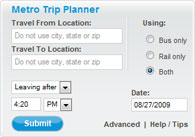Innovation resistance at Metro, part 4: What flaws?
Last week, I explored some of the reasons Metro has resisted, from top-down thinking to unrealistic views of Google to myopia about revenue. There may be another factor at work: Many within Metro simply don’t perceive the value of letting people use the Google Transit trip planner. After all, there’s already a trip planner on wmata.com.
That trip planner isn’t bad. However, there are many ways it could be much better. It doesn’t show a graphical diagram of the route it’s suggesting, for example, or pictures of the alternate routes. If you enter some information, see the results, and then decide to change your search (such as excluding bus or rail trips), when you go back to the home page, your original entries get wiped out, forcing you to retype.
When developing software, it’s easy to become accustomed to one way of using the software, and navigate around the warts. If one method of getting information is easier than another, it’s easy to simply start using the easier route all the time. That’s fine if you’re an average user, but developers have to think outside the box. For that reason, good software development includes user studies.
When I worked at Google, I was involved with creating a feature that displays a list of albums if you type in the name of a band and the word ‘albums’, like this. One time, we user tested the “Search Music” page, and asked the user to try searching for some artist. We expected her to type in the artist name, but she added the word “songs,” and then the system started looking for albums and tracks with the word “songs” in the title. It was easy to fix this, but not something we expected based on the way we ourselves used the prototype.
For example, when you call the NextBus phone number, it says to say the name of a service. One obvious response might be to say the number of your bus. That’s a “service,” right? But actually, that will just confuse the system, which is expecting you to say “NextBus.” That’s far from clear. Kytja Weir of the Examiner told me that she pointed this out, and officials reacted with some surprise. After all, they knew to say “NextBus” right away, so it wasn’t a problem for them.
Besides, why should you have to say “NextBus”? Weir asked this as well, and they replied that they wanted all of the calls to route through one place. Why? It would be far better to have a separate phone number for NextBus, which goes to an interface optimized to help you get your bus, and an otpion. The prompt could say something like, “Welcome to Metro’s NextBus hotline. Say the number of your bus line, or say “customer service” if you want other Metro services.”
I’ve avoided criticizing the trip planner too much because it’s important to encourage agencies to innovate. Remember, Metro was afraid to release NextBus for even an unpublished beta test until they were absolutely sure it was accurate. (And then, when it launched, it was still not 100% accurate). It’s far better for organizations to launch a bunch of technology tools quickly, even if they’re not perfect, than to obsess about getting criticized for the smallest flaw. On Friday, OCTO released a Circulator iPhone app. Some commenters criticized it for being too rudimentary. Of course, more features would be great, but given limited resources, I’d much rather they released a basic app in a short period of time than hold it back for months or years until it’s perfect. We can enjoy it in the meantime.
I’m glad Metro has a trip planner on wmata.com. They did a pretty good job, overall. But it still has its share of flaws. There are also user scenarios, like someone searching for a restaurant on Google Maps and wanting to get directions with a simple click, that the trip planner doesn’t accommodate. And when staff start arguing that the trip planner is good enough as a reason not to keep an open mind about other technological tools, they’ve crossed a line.
Quite simply, Google Transit would be very valuable to riders. It would provide a service much better than what’s available today. It wouldn’t supplant the wmata.com trip planner, but would supplement it. That’s a very valuable service. We could easily argue that it’s so valuable, it’s something Metro could spend money on, just as they spent money on NextBus. Fortunately for Metro, it’s free. That sounds like a very good deal for riders.
You can help us make the case for why Google Transit represents a significant value add for riders. Have you used it in other cities? Post your story: what you were looking for, how you found the information, and why it was useful. An on the flip side, let’s collect some stories about flaws in the existing trip planner. Did it return bad results, or did the user interface make things more difficult than need be? Please be specific, giving particular start and end locations if you can.

